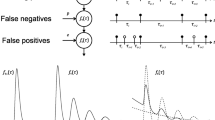Abstract
An error-filtered estimation (EFE) algorithm for estimating the mean and standard deviation of a set of time intervals between consecutive motor unit firing times (inter-pulse intervals (IPIs)) is described. As the input IPI data are filtered and only valid IPIs are used to estimate mean and standard deviation values, the EFE algorithm provides accurate estimates even when the data defining the train of motor unit firing times are only partially complete or have several erroneous firing times. The algorithm has been evaluated using both simulated and real motor unit firing time data, and has been found to provide accurate and unbiased mean and standard deviation estimates, even when up to 70% of the IPI data are incorrect.
Similar content being viewed by others
References
Andreassen, S., andRosenfalck, A. (1980): ‘Regulation of the firing pattern of single motor units’.J. Neurol. Neurosurg. Psychiat.,33, pp. 897–906
Basmajian, J. V., andDe Luca, C. J. (1985): ‘Muscles alive’, (The Williams & Wilkins Co., Baltimore)
Bendat, J., andPiersol, A. (1985): ‘Random data: analysis and measurement procedures, (Wiley, New York)
Claman, H. P. (1969): ‘Statistical analysis of motor unit firing patterns in a human skeletal muscle’,Biophys.,9, pp. 1233–1251
De Luca, C. J. (1978): ‘Physiology and mathematics of myoelectric signals’,IEEE Trans., BME-26, pp. 313–325
De Luca, C. J., LeFever, R. S., McCue, M. P., andXenakis, A. P. (1982a): ‘Behaviour of human motor units in different muscles during linear varying contractions’,J. Physiol.,329, pp. 113–128
De Luca, C. J., LeFever, R. S., McCue, M. P., andXenakis, A. P. (1982b): ‘Control scheme governing concurrently active human motor units during voluntary contractions’,J. Physiol.,329, pp. 129–142
Englehart, K. B., andParker, P. A. (1994): ‘Single motor unit myoelectric signal analysis with nonstationary data’,IEEE Trans.,BME-41, pp. 168–180
Freund, H., Dietz, V., Wita, C., andKapp, H. (1973): ‘Discharge characteristics of single motor units in normal subjects and patients with supraspinal motor disturbances’in Desmedt, J. E. (Ed.): New developments in electromyography and clinical neurophysiology, (Karger, Basal) vol. 3, pp. 242–250
Kukulka, C. G., andClamann, H. P. (1981): ‘Comparison of the recruitment and discharge properties of motor units in human brachial biceps and abductor pollicis during isometric contractions’,Exp. Brain Res.,219, pp. 45–55
LeFever, R. S., andDe Luca, C. J. (1982): ‘Procedure for decomposing the myoelectric signal into its constituent action potentials’,IEEE Trans.,BME-29, pp. 149–162
McGill, K. (1984): ‘A method for quantitating the clinical electromyogram’. PhD Thesis Stanford University, Stanford, California
McGill, K., Cummins, K. L., andDorfman, L. J. (1985): ‘Automatic decomposition of the clinical electromyogram’,IEEE Trans.,BME-32, pp. 470–477
McGill, K., andMcMillan, K. L. (1986): ‘A smart trigger for realtime spike classification’. Proc. 8th Ann. Conf. of the IEEE EMBS, Dallas-Fort Worth, USA, pp. 275–278
Paoli, G. (1993): ‘Estimating certainty in classification of motor unit action potentials’. Masters thesis, University of Waterloo, Canada.
Parker, P. A., Stuller, J. A., andScott, R. N. (1977): ‘Signal processing for the multistate myoelectric channel’Proc. IEEE,65, pp 662–674
Qu, Y., andStashuk, D. (1993): ‘Clustering of motor unit action potentials using shape and temporal information’. Proc. 15th Ann. IEEE Engineering in Medicine and Biology Society Conference, San Diego, California, pp. 1209–1210
Qu, Y. (1993): ‘Automatic clustering of motor unit action potentials using shape and firing time information. Masters Thesis, University of Waterloo, Canada
Rosenfalck, A., andAndreassen, S. (1980): ‘Impared regulation of force and firing pattern of single motor units in patients with spasticity’,J. Neurol. Neurosurg. Psychiat.,43, pp. 907–916
Reiners, K., Herdmann, J., andFreund, H. (1989): ‘Altered mechanisms of muscular force generation in lower motor neuron disease’,Muscle Nerve,12, pp. 647–659
Stashuk, D., andQu, Y. (1996): ‘Adaptive motor unit action potential clustering using shape and temporal information’,Med. Biol. Eng. Comput.,34, (1), pp. 41–49
Author information
Authors and Affiliations
Rights and permissions
About this article
Cite this article
Stashuk, D., Qu, Y. Robust method for estimating motor unit firing-pattern statistics. Med. Biol. Eng. Comput. 34, 50–57 (1996). https://doi.org/10.1007/BF02637022
Received:
Accepted:
Issue Date:
DOI: https://doi.org/10.1007/BF02637022




